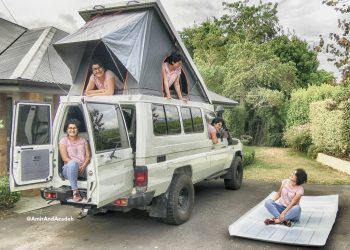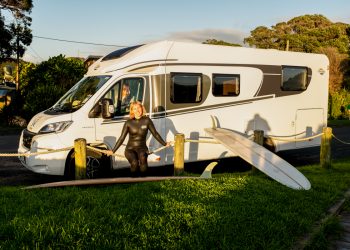The good news is insulation is pretty easy to do and relatively inexpensive. It is just a matter of time and effort. If you’re buying a kitted out camper one of your pre purchase checks will be establishing what’s going on here, so you need to understand how it works too.

It’s curtains for you; there are several glaring holes you’ll identify yourself. The windows. While it’s great to be able to sit in your camper on a stormy day and watch the world go by in comparative comfort and warmth, standard vehicle windows aren’t double glazed [most professional new motorhome builds will have double glazing]. A huge amount of heat transferred through glass and at night you don’t want the outside world watching you undress. So some sort of privacy and insulation is needed. Curtaining is the most obvious choice, it entails adding tracks and ideally knowing someone handy around a sewing machine. Most campers opt for black out and thermal curtains that are either 2 or 3 layers of material sandwiched together. If you’re buying a existing camper check the curtains and rails; are they in good order, are you going to have to replace them straight away. Chances are they are hideous floral patterns that you’ll want to change anyway.
Adding heavy tints to campers is very common, modern retro fitted tint film is pretty inexpensive and has insulative properties. But this won’t help with privacy when the light source is inside the camper at night.
If you have the storage room and don’t mind adding a chore to evenings and mornings, thermal foil barriers can be DIY’s or custom made from products like Reflexics, it’s the silver stuff windscreen shades are made out of. Again this can be sewn into a sandwich of material if you want to avoid that silver look in all your windows. In New Zealand’s comparative mild climate just having good window, roof and floor insulation is probably enough for most campers.
If you want to take it to the next level and are planning to spend a lot of time in the mountains or the Deep South in winter then consider a full thermal wrap for the vehicle. This does open a can of worms and opinions as the best way to go.
There are large hollow cavities between the outside panels in the interior trim. In an empty van these cavities amplify road noise. Insulating the wall cavities will dampen road noise and act as a heat barrier, both ways i.e; a cooler interior in summer and a warmer one in winter. The goal is to wrap the interior in a complete thermal barrier and there’s a whole raft of methods and theories as to what is best. You-Tubing van insulation will bring up pages and pages of how to and whys.
Insulating the walls does create a problem to be aware of; the insulation used can trap condensation in the cavities and this will lead to rust and mould. Keeping the walls free, allows air movement. Also by leaving them as is, you have easy on going access for all your other systems.
One of the less controversial methods is using extruded polystyrene (XPS) panels. These are readily available at hardware stores. They are water resistant and easy to cut and handle.
During the process of installing the insulation be mindful of where wires for lighting, usb ports and water ducting could be going.
Most campers opt on the side of caution when insulating walls and add a vapour barrier. This is a non-porous membrane that gets sandwiched between insulation material and the inside panelling of the camper. It does as the name suggests; prevents moisture from getting to the insulation or bare metal body. This helps prevent any condensation forming and being trapped by the insulation. It is virtually impossible to create a complete vapour barrier as there will be holes made in it for wiring and ducting, but you can certainly barrier off big sections effectively.
Re-paneling
At this point most DIY’ers opt to upgrade the original trims, the door and wall cards. Valuable storage real-estate can be salvaged by creating insets in previously flat wall cards. In your internet searches for interiors you’ll see campers lined with ply panels and/or light tongue and groove wood. It’s a very effective way of making the interior more homely, but it’s also a very practical way of providing sturdy surfaces for securing lights, hooks and charging sockets. Be careful to use products that have no or low VOC’s, not all plywood and wood is the same, some wood is treated and glued with highly toxic chemicals.

















Comments 1